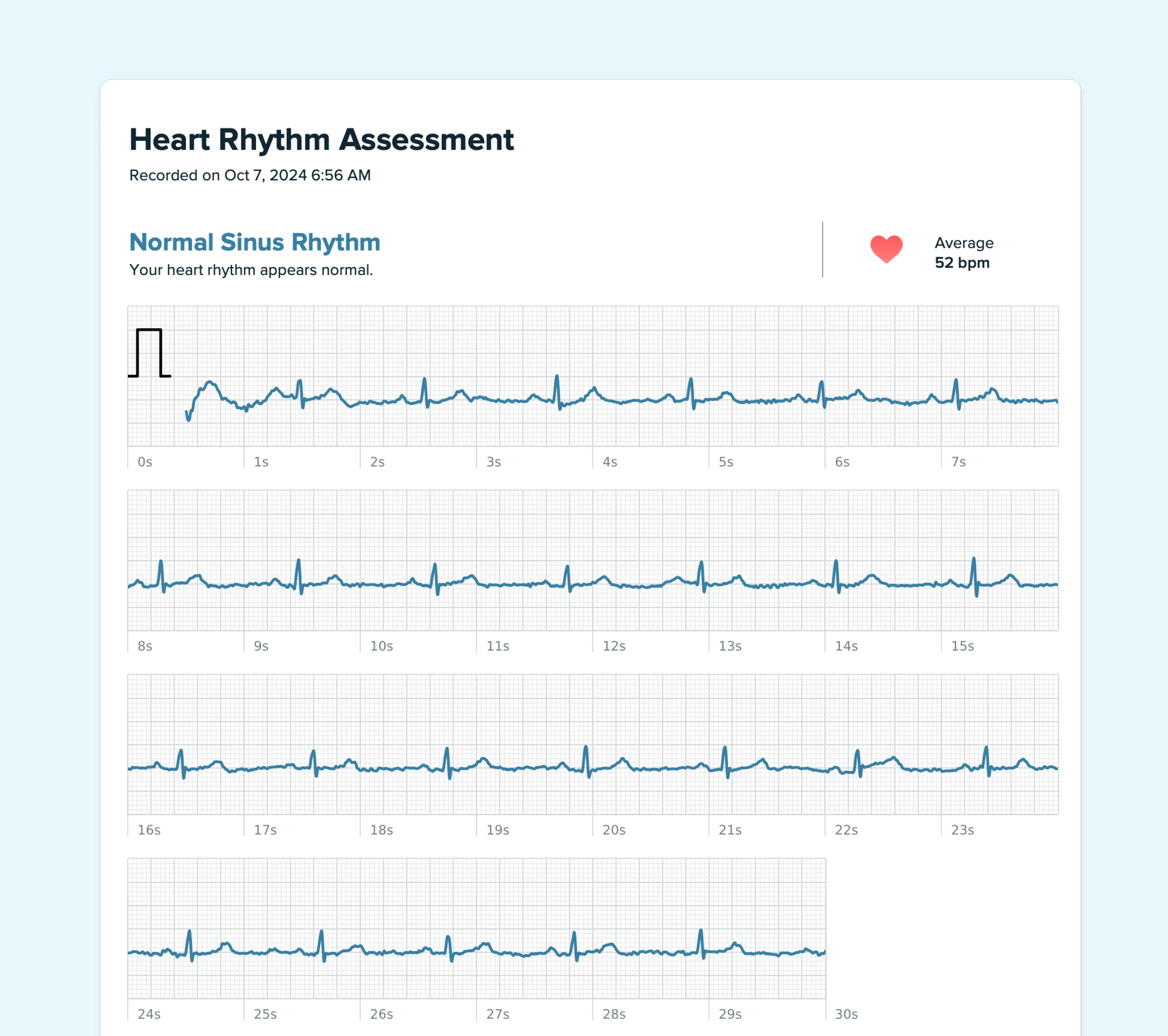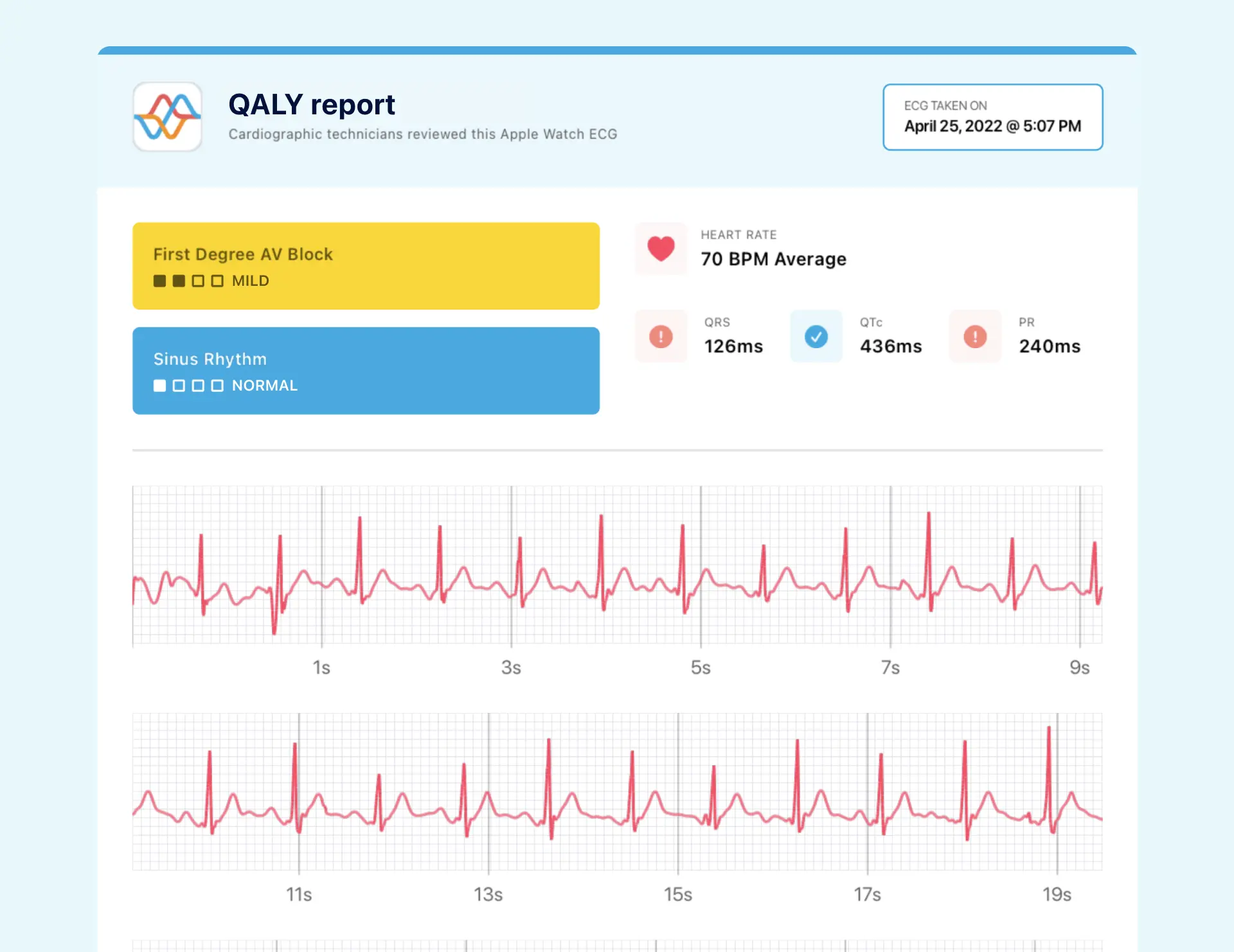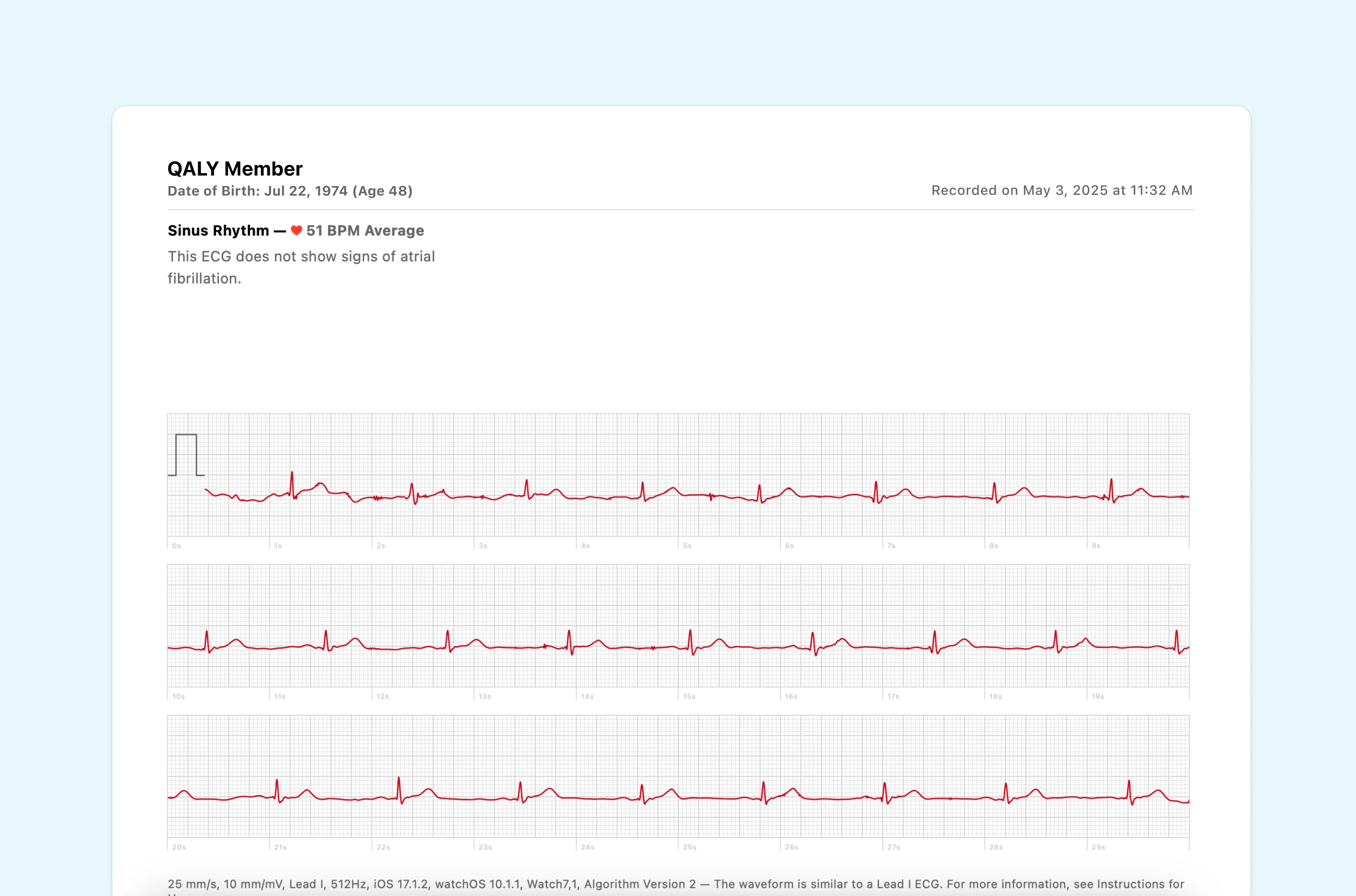Key Takeaways
- Calcium Channel Blockers help lower blood pressure and ease chest pain. They relax blood vessels and, in some cases, slow down the heart’s electrical activity. This helps reduce blood pressure, ease the heart’s workload, and improve blood flow.
- There are two main types with different effects. Dihydropyridines (like amlodipine) mainly relax blood vessels. Non-dihydropyridines (like verapamil or diltiazem) also slow heart rate and are used for certain arrhythmias.
- You might notice ECG changes like a slower heart rate or longer PR interval. These effects are often expected with CCBs and indicate the medication is working. However, if heart rate drops too low or PR interval becomes significantly prolonged, it’s worth monitoring how you’re feeling.
- Common side effects include dizziness, fatigue, swelling in the ankles, flushing, and constipation. Many improve over time or with dose adjustments.
Hi, Heart Hero! In our journey to understand heart health, we often encounter complex terms and medications. Today, we're going to demystify another important class of drugs: Calcium Channel Blockers (CCBs). If you've been diagnosed with high blood pressure, angina, or certain heart rhythm issues, your doctor might have prescribed one of these. At Qaly, we believe that the more you understand about your heart and its treatments, the more empowered you become in managing your health.
So, let's dive into the world of Calcium Channel Blockers – what they are, how they work their magic, and what you might see on your ECG when you're taking them.
What Are Calcium Channel Blockers and How Do They Work?
Imagine calcium as a tiny, energetic messenger within your body's cells. In your heart and blood vessels, calcium plays a crucial role in muscle contraction. When calcium enters muscle cells, it causes them to contract. This is essential for your heart to pump blood and for your blood vessels to maintain their tone.
Calcium Channel Blockers, as their name suggests, work by blocking the entry of calcium into these muscle cells. Specifically, they target specialized channels called L-type calcium channels. By doing so, CCBs lead to:
- Relaxation of Blood Vessels: When calcium entry is blocked in the smooth muscle cells of your blood vessels, these vessels relax and widen (dilate). This reduces resistance to blood flow, which in turn lowers blood pressure.
- Slowing of Heart Rate: Some types of CCBs also affect the heart's electrical system, particularly the sinoatrial (SA) node (your heart's natural pacemaker) and the atrioventricular (AV) node (which controls the electrical signal's passage from the atria to the ventricles). By slowing down the electrical impulses at these nodes, certain CCBs can reduce your heart rate.
- Reduced Force of Heart Contraction: By limiting calcium entry into heart muscle cells, some CCBs can also decrease the force with which your heart muscle contracts.
This dual action of relaxing blood vessels and, for some CCBs, affecting heart rate and contractility, makes them highly effective in treating various cardiovascular conditions.
Types of Calcium Channel Blockers
CCBs are generally divided into two main groups:
- Dihydropyridines: These primarily act on blood vessels, causing vasodilation. They are often used for high blood pressure and angina. Examples include amlodipine (Norvasc), nifedipine (Procardia), and felodipine (Plendil).
- Non-Dihydropyridines: These act on both blood vessels and the heart, affecting heart rate and contractility more significantly. They are used for high blood pressure, angina, and especially for controlling heart rate in certain arrhythmias. Examples include verapamil (Calan, Isoptin) and diltiazem (Cardizem).
There are different types of calcium channel blockers, and the one you’re given is carefully chosen based on what your heart needs most. Everyone’s heart is a little different, so the specific medication is selected to best support your unique situation and help you feel your best.
Why Are Calcium Channel Blockers Prescribed?
Calcium channel blockers (CCBs) play an important role in helping manage a range of heart and circulation-related conditions, making them a key part of many treatment plans.
- High Blood Pressure (Hypertension): By relaxing blood vessels, CCBs reduce the pressure against which your heart has to pump, effectively lowering blood pressure.
- Angina (Chest Pain): Angina is caused by reduced blood flow to the heart muscle. CCBs help by widening the coronary arteries, increasing blood supply to the heart, and by reducing the heart's workload.
- Certain Arrhythmias (Irregular Heart Rhythms): Non-dihydropyridine CCBs (like verapamil and diltiazem) are particularly useful in slowing down a rapid heart rate in conditions like atrial fibrillation or supraventricular tachycardia (SVT) by acting on the AV node.
- Raynaud's Phenomenon: This condition causes blood vessels in the fingers and toes to narrow in response to cold or stress. CCBs can help by relaxing these blood vessels.
Calcium Channel Blockers and Your ECG: What to Expect
If you're taking a Calcium Channel Blocker, especially a non-dihydropyridine type, you might see some characteristic changes on your ECG. These changes reflect the medication's effects on your heart's electrical activity:
Slower Heart Rate (Sinus Bradycardia)
Similar to Beta-Blockers, calcium channel blockers (CCBs) can slow down your heart rate by affecting how electrical signals travel through the SA node, which is the natural pacemaker of your heart. This slowing effect is often intended and helpful, especially if you’re managing a fast or irregular rhythm like atrial fibrillation.
When you’re taking a CCB, your resting heart rate may be a bit lower than usual. For most people, a resting rate between 50 and 70 beats per minute is expected. If you’re athletic or naturally have a slower heart rate, it might even be in the 45 to 50 range and still be considered normal.

That said, if your heart rate consistently falls below 40 beats per minute, or if you begin to feel symptoms like dizziness, extreme tiredness, fainting, or shortness of breath, it could mean your heart is being slowed too much. In that case, it might be worth checking how your body is responding to the medication.
Paying attention to both your numbers and how you’re feeling is one of the best ways to stay in tune with your heart health.
Prolonged PR Interval
Non-dihydropyridine calcium channel blockers can slow down how electrical signals move through the AV node, which can result in a longer PR interval on your ECG. The PR interval is the time it takes for an electrical signal to travel from the upper chambers of your heart (the atria) to the lower chambers (the ventricles).
A typical PR interval ranges from about 120 to 200 milliseconds. If this interval becomes longer than 200 milliseconds, it may be considered a first-degree AV block. While a slightly prolonged PR interval can be a normal response to medication, especially if you’re not experiencing symptoms, it’s something worth keeping an eye on.

In some cases, if the delay becomes more significant, it can progress into higher degrees of AV block, which may affect how well your heart functions. If this happens, you might feel lightheaded, tired, or notice your heartbeat slowing down more than usual.
The key is to pay attention to both your ECG patterns and how you’re feeling. If you notice changes or symptoms that concern you, it could be a sign that your body needs a bit of adjustment to the medication.

It's important to remember that these ECG changes are often expected and indicate the medication is working. However, any significant or new changes on your ECG should always be discussed with your healthcare provider. Your Qaly app can be a valuable tool for tracking your ECGs and sharing them with your doctor, helping them to monitor your heart's response to medication.
Beta-Blockers vs. Calcium Channel Blockers: What's the Difference?
Both Beta-Blockers and Calcium Channel Blockers are powerful medications used to manage various heart conditions, and they can both lower heart rate and blood pressure. However, they achieve these effects through different mechanisms and have distinct applications:
While there's some overlap in their uses, the choice between a Beta-Blocker and a Calcium Channel Blocker (or a combination) depends on your specific condition, other health issues, and how you respond to the medication. Your doctor will carefully consider these factors to determine the best treatment plan for you.
Common Side Effects of Calcium Channel Blockers
While generally well-tolerated, CCBs can have side effects. These often depend on the specific type of CCB and the individual. Common side effects include:
- Headache: Often mild and temporary, especially when starting the medication.
- Dizziness or Lightheadedness: Can occur due to lowered blood pressure or a slower heart rate.
- Flushing: A feeling of warmth or redness in the face and neck, due to blood vessel dilation.
- Swelling in the Ankles and Feet (Edema): More common with dihydropyridine CCBs, this happens because blood vessels in the legs dilate, leading to fluid accumulation.
- Constipation: Particularly with verapamil, this is a common gastrointestinal side effect.
- Fatigue: Some people may feel tired, especially when first starting the medication.
If you notice any side effects that feel uncomfortable or don’t go away, it’s a good idea to listen to your body and explore other options. Sometimes a small adjustment or a different medication can make a big difference in how you feel.
Important Considerations
- Never stop taking your CCB suddenly: Abruptly stopping can lead to a rebound effect, causing a sudden increase in blood pressure or heart rate.
- Inform your doctor about all medications and supplements: CCBs can interact with other drugs, so a complete medication list is essential.
- Discuss pre-existing conditions: If you have certain heart conditions (like heart failure with reduced ejection fraction) or liver/kidney issues, your doctor will need to consider this when prescribing a CCB.
Conclusion
That brings us to the end of our guide on Calcium Channel Blockers. We hope it helped you feel more confident about how these medications work and how they might appear on your ECG.
If you’re still feeling unsure about your heart rhythm or how your medication is affecting it, you’re not alone. This is exactly why we created the Qaly app. It’s designed to help people better understand their heart health. On the Qaly app, human experts review your ECGs and provide clear, supportive insights within minutes. It’s all about giving you peace of mind and a better understanding of your heart.
To get started, download the Qaly app from the App Store or Play Store. If you have any questions or need support, feel free to reach out to us anytime at support@qaly.co.
From all of us at Qaly, stay heart healthy ❤️
Taking calcium channel blockers? On the Qaly app, human experts review your ECGs and help you understand how your medication affects your heart. Start monitoring today.










.png)
.png)